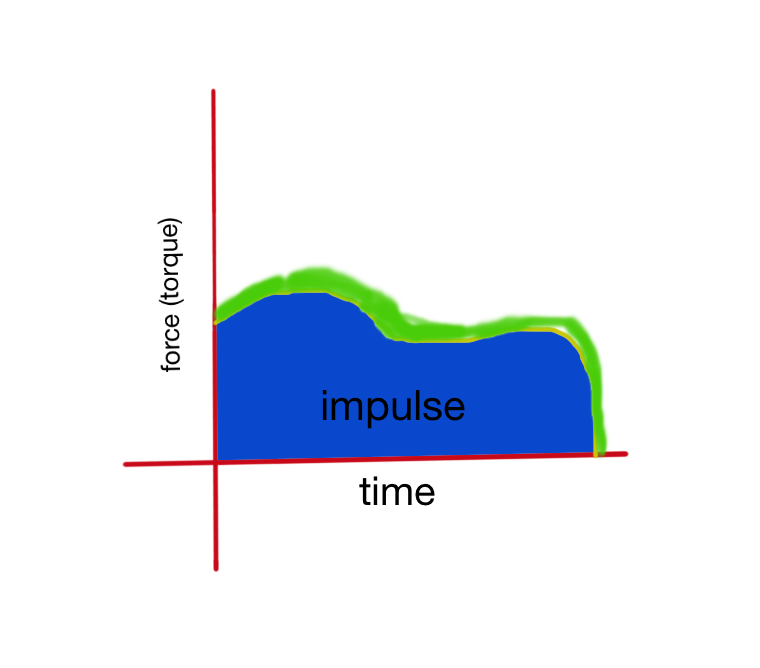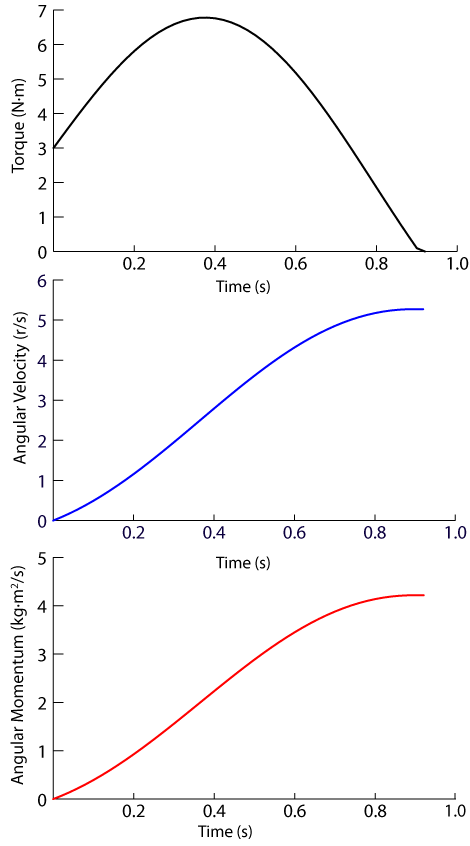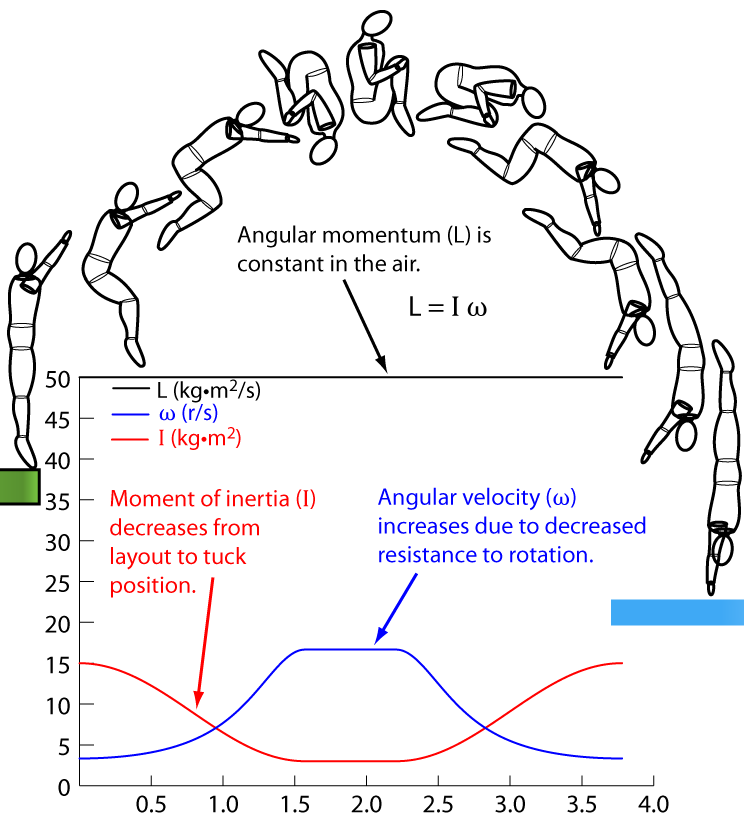Angular Impulse
Claimed by Ashwath Manivannan
The rotational analog of linear impulse, angular impulse represents the effect of a moment of force, or torque ([math]\displaystyle{ \tau }[/math]), acting on a system over a certain period of time ([math]\displaystyle{ \Delta t }[/math]). Angular impulse helps indicate the direction that the torque is applied on the system in (clockwise or counterclockwise) since it relies on the change in angular momentum, L, from a system's initial to final states. It is also associated with change in angular velocity ([math]\displaystyle{ \omega }[/math]) and angular acceleration ([math]\displaystyle{ \alpha }[/math]) and useful in calculating the rotational properties of an object and the torque applied to it.
The Main Idea
Angular impulse is the torque acting over some time interval, or the change in angular momentum. Angular momentum can be changed by an angular impulse. There is no common symbol for angular momentum like how [math]\displaystyle{ \vec{F} }[/math] is for force and [math]\displaystyle{ \vec{p} }[/math] is for momentum, and as a result it is almost always referred to as [math]\displaystyle{ \Delta\vec{L} }[/math], since it is equal to the change in angular momentum [math]\displaystyle{ \vec{L} }[/math], just like how linear impulse ([math]\displaystyle{ J }[/math]) is equal to the change in linear momentum, [math]\displaystyle{ \Delta\vec{p} }[/math]. 
A Mathematical Model
To understand angular impulse, torque and angular momentum must be dissected to observe the physics of angular impulse. The definition of torque is ∑τ=Iα, where I is the moment of inertia of the system and α is the angular acceleration of the system. α, is derived from the change in angular velocity over time. α = Δω/t Angular impulse can now be expressed in terms of torque, moments of inertia, and angular velocities by this relationship.
∑τ (t) = I(Δω) The angular impulse is equal to the moment of inertia [math]\displaystyle{ I }[/math] times the change in angular velocity [math]\displaystyle{ \Delta\vec{\omega} }[/math]
Another way to derive angular impulse is by using the net cross product of a force vector, [math]\displaystyle{ \vec{F} }[/math], applied at a particular location a vector distance [math]\displaystyle{ \vec{d} }[/math] from a pivot point times a specified time interval [math]\displaystyle{ \Delta t }[/math]. This is also equal to the net torque [math]\displaystyle{ \sum{\vec{\tau}} }[/math] times a specified time interval [math]\displaystyle{ \Delta t }[/math].
[math]\displaystyle{ \Delta \vec{L} = \sum{(\vec{d}\times\vec{F})}⋅\Delta t = \sum{\vec{\tau}}⋅\Delta t }[/math]
[math]\displaystyle{ \Delta \vec{L} = I\Delta\vec{\omega} = I\vec{\omega_f} - I\vec{\omega_i} }[/math]
∫τ dτ = I(Δω)
Taking the integral of the function of torque over a period of time will also give us angular impulse.

Angular Momentum Principle
The angular momentum principle directly involves angular impulse as shown in the equation below:
ΔL = τ-netΔt Both sides are equal to the net angular impulse for a system. Thus, angular momentum is a measure of how much or little torque is applied to an object over a period of time. When a system is in the air, it is safe to say that the angular momentum of that object is constant because the only force acting on it is gravity, since the object cannot push or pull against anything to produce external torque. This constant angular momentum of an object spinning in midair is a perfect example of the momentum principle, or moreso the conservation of momentum. Even though the system may experience a spectrum of inertias throughout its midair flight, the gravitational force on it is constant, so the sum of torques is also constant, which theoretically should equal 0 since the system experiences no changes in angular momentum.
Example: Spring through the air A spring, initially stretched past its equilibrium, thrown in the air with an initial spin would have constant angular momentum even though the spring would oscillate back and forth. When the spring is compressed, moment of inertia would decrease (meaning it takes less to rotate the spring) so the angular velocity would increase. When the spring is stretched out, making it harder to rotate, the moment of inertia would increase consequently decreasing angular velocity. At any time during its path, the angular momentum is conserved, which goes to show that angular impulse is 0 since no net torque was applied on the object.
Example: skater When a skater goes to do a triple axle in the air, he/she tucks in initially to get maximum angular velocity with decreased moment of inertia to gather as much angular momentum as he/she can before jumping into the air and gracefully spiralling back down. While midair, he/she may choose to tuck in more to increase the number of spins, or decide to splay out limbs to increase inertia to slow down. The whole time, angular impulse is 0 since he/she maintains the angular momentum he/she started with due to the momentum principle.
Units
The units for angular impulse are the same as those for angular momentum: [math]\displaystyle{ kg⋅m^2/s }[/math] or [math]\displaystyle{ N⋅m⋅s }[/math].
A Computational Model
Angular impulse is often used to update angular momentum when there is a torque acting on an object. Much like how force times time (impulse) is used to update momentum by adding it to an initial momentum in order to obtain the final momentum when the force is constant, angular impulse can also be used to find final angular momentum or final angular velocity. This can be done by adding angular impulse to an initial angular momentum in a while loop and setting that equal to the final angular momentum. Below is part of a simple code example of a while loop that will update the final angular momentum by adding angular impulse. The final angular momentum is angm_f, the initial angular momentum is angm_i, torquenet is the net torque, deltat is some pre-defined time step, and t is time.
In order to find final angular velocity, one could simply divide the final angular momentum by the moment of inertia (a constant) within the while loop after updating the final angular momentum (angm_f in the example) and before updating the time (t in the example).
Examples
Simple
The moment of inertia of an upright solid cylinder is 22.5 m ⋅ r^2. The cylinder is rotated from rest and has a final angular velocity of 5 rad/s. What is the angular impulse of the cylinder?
Solution
We are given the moment of inertia, final angular velocity, and deduce that the initial angular velocity is 0 rad/s since it began rotating from rest. As a result, we can find the angular velocity by multiplying the moment of inertia with the change in angular velocity, or 5 rad/s minus 0 rad/s times 22.5 m ⋅ r^2. This gives us the angular impulse, 112.5 N ⋅ m ⋅ s.
Middling
A net force of 40 N is applied to the rim of a spinning wheel for 2 seconds. The radius of the wheel is 20 cm. Find the angular impulse that is applied to this wheel.
Solution
First, we need to find the torque acting on the wheel. Torque is equal to the applied force times the radius, or 40 N ⋅ .2 meters which equals 8 N ⋅ m. Currently, we know the torque applied as well as the duration of its application. Therefore, we can find the angular impulse, which is the applied torque times the duration, or (8 N ⋅ m) ⋅ (2 s) which equals 16 N ⋅ m ⋅ s, the angular impulse.
Difficult
A point on a solid disk on the xy-plane with radius 5 cm rotates with a constant initial frequency of 5 revolutions per second. The mass of the disk is 2 kilograms. Someone applies a force to the wheel suddenly, giving it a constant angular acceleration of 6 rad/s^2 for 3 seconds. Use the angular impulse to find the final angular velocity.
Solution
This problem involves several steps. It is clear that if we are going to find the angular impulse, we either need to find the torque times the time interval or the change in angular velocity. For finding the angular velocity, we are given the initial frequency and radius of the disk, so since angular velocity is equal to 2 times pi times the frequency, we get 10⋅pi rad/s for the initial angular velocity.
Now that we have the initial angular velocity, we need to somehow find the final angular velocity. Since angular impulse is the change in angular velocity, we can use this to determine what the final angular velocity is.
Angular impulse is equal to torque times time. Remember that the torque is equal to the moment of inertia times angular acceleration. We are told that we are dealing with a solid disk, so we need to find the moment of inertia which is mr^2, or 2 kg ⋅ (.05 m)^2, which gives us a moment of inertia of .005 kg ⋅ m^2. Since we are given the angular acceleration and have the moment of inertia, we can now find the torque, which is equal to (.005 kg ⋅ m^2) ⋅ (6 rad/s^2), or .03 N⋅m.
Since we now have the torque and the duration that it is applied is given, we can now find the angular impulse. We multiple the torque by time, or (.03 N⋅m) ⋅ (3 s), and get .09 N⋅m⋅s as our angular impulse.
Now that we have the angular impulse, we can find the final angular velocity. Before that, we need our initial angular momentum, which we get by multiplying the initial angular velocity by the moment of inertia. This gives us .05 pi or about .157 N⋅m⋅s. We have the angular impulse, so we add this to the initial angular momentum and get our final angular momentum, about .247 N⋅m⋅s. Then we divide by the moment of inertia to get the final angular velocity, about 49.42 rad/s.
Connectedness
Angular impulse is present in so many things in daily life, from wheels turning on a bicycle to turning the steering wheel in a car and even a person just spinning around in place. Knowing the angular impulse of an object us can help us understand how the net torque is changing over time. As we took the integral of torque over time for impulse, we can take the derivative of the impulse graph at any point to figure out the torque applied at that current time. This is useful in calculations of electron spin, and particle analysis.
Angular impulse has numerous industrial applications, being critical in any rotating device, like cars (wheels, steering wheels), generators, and even in water/wind mills which can provide hydroelectric/wind power.
See also
The Angular Momentum Principle
External links
Angular Momentum Impulse Video
References
Chapter 11 of Matter & Interactions 4th Edition

